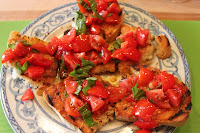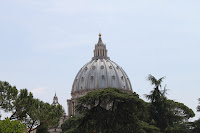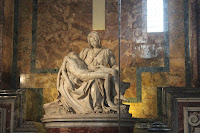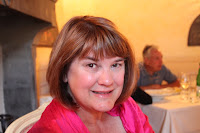Sunday, July 3, 2011
We're Home!
Thursday, June 30, 2011
Lisbon, Portugal (by Gabe)






My favorite thing in Lisbon was the Oceanario de Lisboa (or the Lisbon Aquarium). My Mom and I went to the big aquarium. When you first walk in there is a turtle exhibit. There was one smaller sea turtle and one that was big. It reminded me of a turtle that I saw when we were snorkeling in Maui. There is a clear plastic pathway at the aquarium that you walk across so you can see the sea life under you. When you leave the turtle exhibit, you come to a section that has a variety of sea life, such as sharks, sting rays, amphibians, jellyfish, penguins, otters, and much more. There is a large tank where the sharks, sting rays and many other fish live and an environment set up for penguins. Some unusual sea life that I saw included a fish that looked like a plant, a large oddly mouthed blue fish, and a long eel about 4.5 inches in diameter. I also went to the zoo with my Dad (while my Mom was at her conference) and saw a monkey that had a large adams’s apple that puffed up; he also made a very strange noise that sounded like a long honk followed by a scream. Very odd. We also saw cool peacocks with long feathers. I knew their big feathers fanned out when they were threatened by predators, but I didn’t realize how long their feathers were. It was fun seeing all of the cool fish and animals up close. This is probably what I will remember about Lisbon. Oh, also we had fun eating dinner with my Mom’s students, April, Manning, and Angela.
Saturday, June 25, 2011
London--The place to be (by Hiller)






During our stay in London, Wimbledon and a U-2 Concert happened, and the city was getting ready for the 2012 Olympics. Although we didn't have tickets to attend these events, we could feel the energy throughout the city. We have been able to walk most places from our hotel, but the few times we’ve taken a cab have proven most delightful. The drivers are hospitable and talkative, ready to share their opinions and insights about the city and British culture. All of our cab drivers shared at least two perspectives. First, they all think Charles should not be king, but should be passed over so William can enjoy the title. They think Charles has little credibility and would not represent the royal family well. Second, they think that the Diana Memorial that was established by the Queen in 2004 is an embarrassment. They don’t understand why the Queen did not commission a traditional statue of Diana rather than a water feature (or as several drivers referred to it—the waterhole). When we visited it, I understood the cab drivers' perspectives. I think the memorial designers were trying to capture Diana’s unique spirit, but unfortunately the concept was not executed well. If you visit the Memorial some day, let us know what you think. Much of our time in London was spent trying to remember our British history as we enjoyed the many and varied historical sites. It was amazing how much Tom and I could remember, given it's been more than 30 years that we studied British history. A few of the places we visited were: Big Ben, Tower of London, the London Tower Bridge, Westminster Abbey, Buckingham Palace, and the Diana Memorial in Kensington Garden. We also took a turn on the London Eye (think huge ferris wheel), which enabled us to view the city from 450 feet. I was a bit queasy but soon relaxed when I realized that our car did not wobble and swing back and forth like a traditional ferris wheel. We’re going to visit the Tate Modern tomorrow (our last day) to get our contemporary art fix before moving on to Lisbon.
Wednesday, June 22, 2011
Normandy--Pausing to Reflect (Tom)






On Sunday, we left Paris and made our way to Normandy. While the Normandy countryside is beautiful, and most of the scars to the terrain caused by the War sixty-five years ago have been covered over by time, there is an overwhelming atmosphere that this is an important place and that great sacrifices were made here. Tourism-wise, D-Day and the Battle of Normandy are important industries, but matters are conducted with a sense of respect and dignity for Normandy’s history. That feeling culminates at the American Cemetery, just behind Omaha Beach, where 9,387 Americans who died in the Battle of Normandy are buried. From the middle of the Cemetery, you are surrounded in all directions by the headstones of the graves of those who died so far from home (even further in 1944, before international travel was common). All of the graves face west—looking toward the United States. Most of the headstones are marked with the name, unit, date of death and home state of the person buried. North Carolina, Georgia, Wyoming, Mississippi, New York, Oklahoma, Kansas—all the states are there. Most of the grave markers have a cross at the top of the marker, although there are some topped with the Star of David. The dates of birth are not included, but we guessed that most of the dead were only 18-25 years old—kids whose lives were brought to such a short end by the war. Some of the headstones do not include any information, but only a short statement --“Here lies an Honored Comrade in Arms—Known But to God.” On this trip and on other trips to Europe I have seen many amazing things—and am grateful that I have had the chance to do so-- but nowhere has touched me the way this green lawn with its markers of rising crosses and stars lined in long rows touched me. In addition to our somber visits to the Cemetery, Omaha Beach and other D-Day related sites, we also spent some time in the very lovely town of Bayeux (the first town liberated by the Allies). We saw a somewhat entertaining 1000 year-old 285 foot long tapestry depicting the Norman invasion. The headphone audio guide included a guide for children, which Gabriel enjoyed quite a bit. The three of us also enjoyed playing tennis on the court at the Chalet where we were staying, made even more exciting by the cheers in the form of “Moo” we heard from the dairy cows in the pasture just beside the court. We also had several delightful meals at authentic French Bistros, where our inability to speak French was put to a challenge. Despite a few misfires—our Fruit de Mers plate included escargot (which was left untouched), we ate well.
Thursday, June 16, 2011
Eiffel Tower (by Hiller and Gabe)




After a grueling (think hot, muggy, cramped space with three people trying to sleep) overnight train-ride from Venice through the Alps, we’re in Paris! C’est la vie. We took a day to recover and then ventured out to see the Eiffel Tower. What a sight to behold. One thousand sixty-three feet of steel perfectly aligned to create a master- piece. It’s funny that at one point the tower was believed to be too gaudy for the avant-garde artistic community in Paris. But they came around and now the tower is beloved by all who view it. (by Hiller) The top of the tower was closed so, we only went up to the second floor. Still, it was a great view. That same night we met Glenn, Elizabeth, Jeremy and Rachel (friends from Raleigh) and had a great dinner at a French café. Afterwards, we made another trip to the Tower. It was lit up from bottom to top with spot-lights shooting out from the top! On the video you can hear how we each said a word to describe the tower. As we made our way back, the tower suddenly started to flash, as you will see in a different video. It’s a great place to visit. I would highly recommend it, especially at night! (by Gabe)
Tuesday, June 14, 2011
Venice-water, water, everywhere (by Tom)






On Saturday morning, we made our way by train to Venice for a whirlwind, 2.5-day stop. While everyone should see Venice at least once, it is a demanding city to visit in that the tourists out number the Venetians by a huge margin. Our highlight was a guided tour by our tour guide, Fernando, who took us on a 3-hour walking tour on Monday. Fernando’s tour ranged from the subtleties of the architecture and mosaics of St. Mark’s Basilica, to a description of Venetian life in the city’s heyday, to the modern-day struggles it has in continuing its existence as something other than a tourist stop. The highlight of any first-time visit to Venice will be St. Mark’s square, where we spent a lot of time. When the open-air orchestras are playing in the square, the thousands of tourists are passing through posing for pictures, and the children are feeding and playing with the pigeons, the square takes on a magical quality.Gabriel set the record for most pigeons fed in a two-day period. While we spent most of our time in the St. Mark’s area, we did venture to the Guggenheim museum, featuring the private collection of Peggy Guggenheim. Peggy was an important patron of contemporary art in the 20th century, providing support to many modern artists, such as Jackson Pollock.
Friday, June 10, 2011
It's leaning all right! (by Gabe)



Today we went to the Leaning Tower of Pisa, which was about 2.5 hours from our Villa. In route to Pisa, we had lunch at St. Gimignano, where my Dad had a fender bender with a local Italian woman. Interestingly, another driver had just hit her before Dad hit her. Fortunately, there was just a small scratch on her car and we were able to settle up without having police involved. Next on to Pisa! It was so cool when we first saw it because we had no idea that it would be leaning so much. Also, it’s not that tall—only 186 feet on the leaning side and 194 feet on the tall side. We climbed to the top and we could feel ourselves off balance. As we climbed the spiral staircase we could feel ourselves leaning with the tower. We learned that the Tower sat unfinished for 100 years before an architect figured out how to finish it without it falling over. The picture to the left is my Mom and me at the top of the tower. This was my favorite site in Italy so far.
Wednesday, June 8, 2011
Ah Florence! (by Hiller)
We took an early train in to Florence to spend a day bathing in Renaissance history. Even though Florence hosts about 1/2 million people, it seemed extremely intimate compared to the vastness of Rome. The highlight of our day was viewing Michelangelo’s David. Michelangleo completed the sculpture at the age of 26 out of one huge piece of marble. This work established him as the greatest sculptor of his time. In recent years, a viewer tried to vandalize the sculpture so now they have a protective barrier around it. You can see on David’s left ankle where the repair was made. (They wouldn't let us take a photo of it). The Ponte Vecchio is the old bridge in Florence that has shops built in on both sides. It use to have fish markets, but the Medici family ordered the jewelers to relocate their stores on to the bridge to replace the fish markets. The Medici palaces were located next to the bridge and they would have to walk past the fish market every day. Since it was smelly, they did not like that! So out with the fish and in with the diamonds. A recent trend has been for young lovers to place a lock near a fountain and throw the key into the river to secure their love for eternity. (Listen to our guide Cynthia talk about this new custom on the video below). The Basilica di Santa Maria del Fiore is the cathedral church (Duomo) of Florence begun in 1296 in the Gothic style with the design of Arnolfo di Cambio and completed structurally in 1436 with the dome engineered by Filippo Brunelleschi. Brunelleschi completed the dome without scaffolds, which was quite an accomplishment at the time. What a magnificent site!
Monday, June 6, 2011
Tom celebrates 54th birthday w/ cooking class in Tuscany (by Tom)






Saturday, we said goodbye to Rome and made our way to Tuscany. After a few wrong turns in our rental car, we found our hotel, the Villa de Piazzano, near the town of Cortona. The villa is wonderful and we have met many friendly tourists—mostly Americans, and, interestingly, mostly southerners (two couples from Virginia, one from South Carolina, one from Tennessee and another from North Carolina). The villa has a restaurant, overseen by Chef Gabrielle. In celebration of my birthday, we had a cooking class with her that is the highlight of our trip to this point. Gabrielle told us that cooking is her passion and it shows in her cooking lessons. Delighted that they shared the same name, she ordained Gabriel as her special helper.
We started in the garden, where we picked fresh lettuce, oregano, sage, basil and other spices and vegetables to be used in our lesson. From there we proceeded to Gabrielle’s kitchen, where we had a hands-on Tuscan cooking lesson. We cooked a five-course meal consisting of bruschetta with tomatoes and basil, ricotta-stuffed eggplant, handmade from scratch ravioli with a gorgonzola stuffing (I see a pasta making machine in my future), ginger honey pork tenderloin and finally a strawberry tiramisu. While the food was wonderful, it was Gabrielle’s manner that made the lesson an experience to remember. We were her only three students today (she never has more than 6 students for a lesson) and she gave us her absolute attention as teacher and hostess. All of us participated in the preparation. At the end of the class, she gave us a memento and the recipes we cooked today. We will be trying them out on some of you when we get home. What a wonderful birthday celebration!
Friday, June 3, 2011
Roman Holiday (by Tom, Hiller & Gabe)






We realize that up to now we have been taking in Europe in small bites, albeit very good small bites. Then we came to Rome and our small bites became an all-you-can-eat buffet. In every direction you look, Rome overwhelms you with its almost 3,000 years of history. Ancient ruins, narrow streets, fountains, monuments, churches, medieval and renaissance houses and hotels are in all directions. Here are some highlights:
Spanish Steps. We started our site seeing at the Spanish Steps, one of the many gathering places for tourists. We felt a bit like we were on our class trip, because all around us we saw American teenagers with their backpacks taking pictures and otherwise acting like teenagers (well behaved teenagers). Other than the persistence of the vendors trying to sell their roses, the Spanish steps are a great first place to see with spectacular views, lots of energy and overall fun. Almost at the foot of the steps is a fountain, the first of so many we would encounter in Rome—clearly something Raleigh needs to add on Fayetteville Street.
John Keats House. At the bottom of the Spanish Steps is a house one occupied by that famous Roman, John Keats. Actually the English Romantic poet Keats lived in this house a few months before he died there from tuberculosis in 1827. In the early 20th century it was purchased and converted to a museum/memorial for him and Percy Blyss Shelly, who had some connection to Keats. In the Keats house, one can see the room where Keats died, furnished as it would have been furnished. This stop was a somewhat quirky interlude from the grandeur of the Spanish Steps and the energy of the street just outside the house. Add to the very long list of things I learned on this trip—Mary Shelly, who wrote Frankenstein, was the wife of Percy Shelly. Hiller had seen the movie, Bright Star, a few years ago, which was based on Keat's life. The docent said that the movie was tightly based on the historical records.
Trevi Fountain and the Pantheon. We next found our way to the Trevi Fountain. It was designed by Nicola Salvi and completed in 1762. The 1954 film, Three Coins in a Fountain, brought renewed interest in this spot. The Pantheon, which means “All the Gods,” was built in 31 B.C. by Augustus Ceasar. We were amazed at the structure, which is considered one of the architectural wonders of the world because of its dome and concept of space.
The Vatican. The Vatican, in a word, was overwhelming! It is 1500 years of what has been the best of western culture. We could have spent a day at the Sistine Chapel (1508-1512) viewing the artistry of Michelangelo. It’s difficult to imagine the physical demands of painting the fresco on a tremendously high scaffold while lying down, but that’s what Michelangelo did. The dome at St. Peter’s Basilica, also designed by Michelangelo, was based on the design of the Pantheon dome. The church is designed to be overpowering, with its statues, frescos, sculptures, ornate artistic detail. St. Peter is recognized at the founder of the Catholic Church and is revered on every turn throughout the Basilica. We had a guide, named Franscesca, who took us on a 3-hour tour of the Vatican and pointed out the political, religious, and artistic high spots of this amazing collection of historical artifacts. Remarkable!
The Colosseum. Today we braved the crowds to get a glimpse of the magnificent Colosseum, which was built around 79 AD. We learned that it was abandoned for over 1000 years, with people removing marble and metals to use in construction of other structures. Today, it is the biggest tourist attraction in Rome, if not in Europe. We imagined the gladiators engaged in fierce matches, with the Emperor and thousands of citizens cheering them on. One guide told us that it was not unusual for the Romans to bring in exotic animals from Africa (lions and elephants) and have them fight—all for entertainment purposes.
Sunday, May 29, 2011
Fun in Athens, Greece. (by Gabe Lee)


Today we visited Athens, Greece. There were three things I liked about Athens. The 1st thing was the Acropolis. The 2nd thing was a dog at the Acropolis. The 3rd thing was lunch. At the Acropolis we saw the Parthenon. It is all pretty much still standing. It was built for the goddess Athena, the goddess of wisdom. There was another temple there built for Athena and Poseidon. Poseidon was the god of the sea. At the Parthenon I met a dog that loved belly rubs. I went up to pet him and he rolled over right when I got to him. So I rubbed his belly, and when I stopped he clawed and pushed at me so I would rub him some more. So I did. Then the next time I stopped, he stayed rolled over to show me he still wanted more, so I rubbed him some more. Then I stopped again and he still stayed rolled over. I decided to stop because he probably would have kept me there awhile. After visiting the Parthenon, we went to the National Museum of Archeology, where we saw a lot of ancient Greek art. Then we had lunch at a place called Yeppo. We ate cheese and spanikopita, a Greek salad, beef over orzo (rice dish), & fruit. I thought it was very good! We had a good time in Athens, and I think it would be fun to go back again sometime!!





